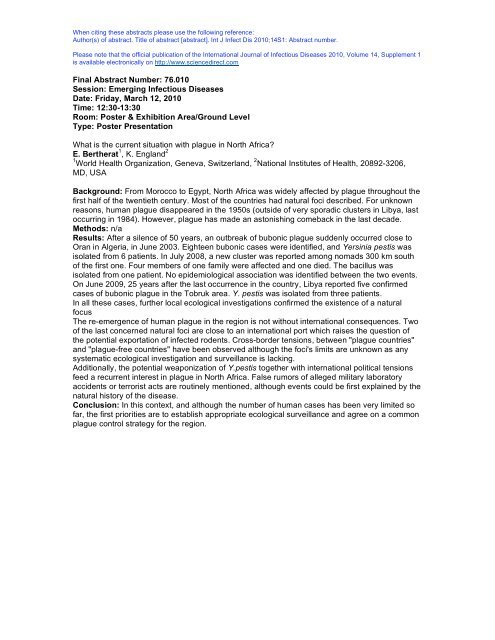14th ICID - Poster Abstracts - International Society for Infectious ...
14th ICID - Poster Abstracts - International Society for Infectious ...
14th ICID - Poster Abstracts - International Society for Infectious ...
You also want an ePaper? Increase the reach of your titles
YUMPU automatically turns print PDFs into web optimized ePapers that Google loves.
When citing these abstracts please use the following reference:<br />
Author(s) of abstract. Title of abstract [abstract]. Int J Infect Dis 2010;14S1: Abstract number.<br />
Please note that the official publication of the <strong>International</strong> Journal of <strong>Infectious</strong> Diseases 2010, Volume 14, Supplement 1<br />
is available electronically on http://www.sciencedirect.com<br />
Final Abstract Number: 76.010<br />
Session: Emerging <strong>Infectious</strong> Diseases<br />
Date: Friday, March 12, 2010<br />
Time: 12:30-13:30<br />
Room: <strong>Poster</strong> & Exhibition Area/Ground Level<br />
Type: <strong>Poster</strong> Presentation<br />
What is the current situation with plague in North Africa?<br />
E. Bertherat 1 , K. England 2<br />
1 World Health Organization, Geneva, Switzerland, 2 National Institutes of Health, 20892-3206,<br />
MD, USA<br />
Background: From Morocco to Egypt, North Africa was widely affected by plague throughout the<br />
first half of the twentieth century. Most of the countries had natural foci described. For unknown<br />
reasons, human plague disappeared in the 1950s (outside of very sporadic clusters in Libya, last<br />
occurring in 1984). However, plague has made an astonishing comeback in the last decade.<br />
Methods: n/a<br />
Results: After a silence of 50 years, an outbreak of bubonic plague suddenly occurred close to<br />
Oran in Algeria, in June 2003. Eighteen bubonic cases were identified, and Yersinia pestis was<br />
isolated from 6 patients. In July 2008, a new cluster was reported among nomads 300 km south<br />
of the first one. Four members of one family were affected and one died. The bacillus was<br />
isolated from one patient. No epidemiological association was identified between the two events.<br />
On June 2009, 25 years after the last occurrence in the country, Libya reported five confirmed<br />
cases of bubonic plague in the Tobruk area. Y. pestis was isolated from three patients.<br />
In all these cases, further local ecological investigations confirmed the existence of a natural<br />
focus<br />
The re-emergence of human plague in the region is not without international consequences. Two<br />
of the last concerned natural foci are close to an international port which raises the question of<br />
the potential exportation of infected rodents. Cross-border tensions, between "plague countries"<br />
and "plague-free countries" have been observed although the foci's limits are unknown as any<br />
systematic ecological investigation and surveillance is lacking.<br />
Additionally, the potential weaponization of Y.pestis together with international political tensions<br />
feed a recurrent interest in plague in North Africa. False rumors of alleged military laboratory<br />
accidents or terrorist acts are routinely mentioned, although events could be first explained by the<br />
natural history of the disease.<br />
Conclusion: In this context, and although the number of human cases has been very limited so<br />
far, the first priorities are to establish appropriate ecological surveillance and agree on a common<br />
plague control strategy <strong>for</strong> the region.
















